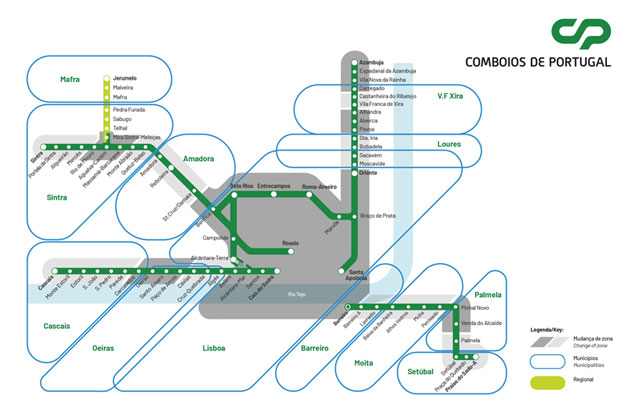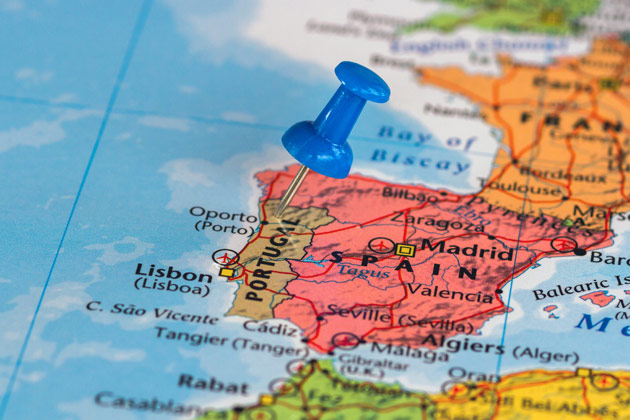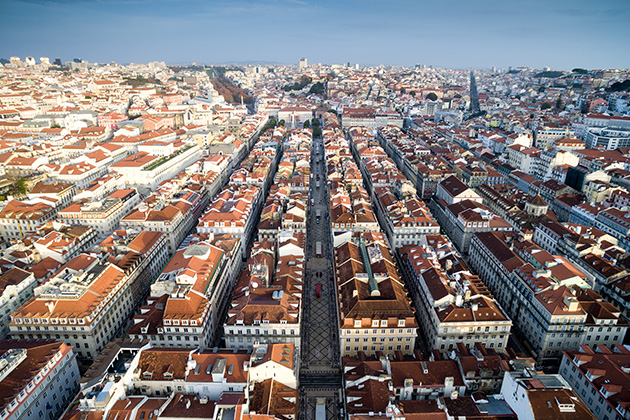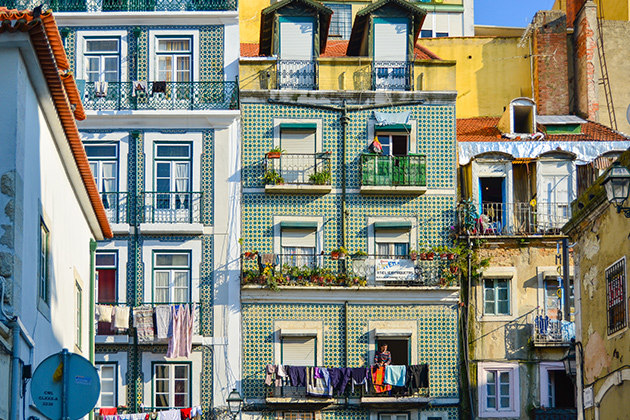
Lisbon isn’t very big if you compare it to other European capitals like London or Paris. Nonetheless, the public transport system remains the fastest and most efficient means of getting around, not only in the city proper, but also in neighbouring areas. See what options you have.
Underground

The underground is one of the most popular systems for getting around Lisbon. The network runs between 6h30 and 1h00, along four lines:
- Blue line: Connects Reboleira to Santa Apolónia, with 18 stops, including the Marquês de Pombal, Avenida da Liberdade, Restauradores, Baixa-Chiado and Terreiro do Paço;
- Yellow line: This line connects Odilvelas to the Rato, over 13 stations. It crosses the green line in Campo Grande, the red line in Saldanha and the blue line in the Marquês de Pombal. You can also connect to the train line at Entrecampos;
- Green line: The green line runs from Telheiras to Cais do Sodré. There are a total of 13 stations, although the one at Arroios is closed for renovation at the moment and is only expected to open towards the end of 2020. It also connects to the train lines at Roma-Areeiro and Cais do Sodré;
- Red line: This line has a total of 12 stations, between the Airport and São Sebastião. It connects to the train line at the Oriente station.
When compared to the 11 lines of the London underground or the 16 lines of the Paris network, the Lisbon underground system is relatively simple, although it does cover a significant part of the city.
How much does the underground cost?
Each individual trip on the underground costs €1,50, but it has to be charged to a specific Viva Viagem/7 Colinas card, which costs €0,50. So if you don’t yet have a card, your first trip will cost €2 (€0,50 for the card, €1,50 for the trip). The trip is valid for one hour, and transferable to the bus within that timeframe. So, for example, you can enter the underground at 10h00 and then leave at your destination and catch a Carris bus until 11h00.
However, you cannot leave the underground system and return using the same trip. If you do, you’ll have to pay for a new one. You can also charge your card with a 24h pass, which is valid for Carris and the CP train system, or the Transtejo/Soflusa ferries. The pricelist for the Lisbon underground can be found here.
A cheaper option could be the zapping system, which allows you to charge the same Viva Viagem/7 Colinas card with anywhere between €3 and €40. By paying in advance, each underground trip will only cost you €1,33, which is lower than the usual individual price, and this amount will be deducted from the balance of your card. You can also use it in the same way on the Carris transports (buses, trams, the Santa Justa elevator and funiculars), CP trains, Transtejo/Soflusa ferries, Fertagus and the MTS, which are the train and tram system, respectively, that operate on the south side of the river.
Tickets for the underground can be purchased at the stations, both at the ticket office and vending machines.
Train
There are two train operators in Lisbon: CP and Fertagus.
CP

The CP train lines which are connected to Lisbon are the Sintra/Azambuja and the Cascais lines. The Sado line trains go to Barreiro, on the southern bank of the Tagus, beginning at the Sado Beaches. From Barreiro you will need to catch a ferry to reach Lisbon.
- Sintra/Azambuja Line: This connects the Sintra and the Azambuja stations. You can connect to the underground at the Rossio, Sete Rios, Entrecampos, Roma-Areeiro, Oriente and Santa Apolónia stations.
- Cascais Line: The Cascais line connects Cascais to Cais do Sodré, in downtown Lisbon. It is composed of 17 stations and connects to the underground in Cais do Sodré.
- Sado Line: The Sado line runs from the Sado river beaches to Barreiro, on the Southern margin of the Tagus. Although it does not connect directly to Lisbon, from Barreiro you can catch a Transtejo Soflusa ferry to Terreiro do Paço, on the Lisbon side of the river.
How much do the trains cost?
The cost of riding the train depends on the number of zones you cross:
- 1 zone: €1,35
- 2 zones: €1,65
- 3 zones: €1,95
- 4 zones: €2,25
- 5 zones: €2,55
So, for example, a trip between the Sintra and Rossio stations crosses four zones, costing €2,25. But if you catch the train in Cacém, you only pay for three zones, making it €1,95. As with the underground, these trips must be charged to a Viva Viagem/7 Colinas card, which costs €0,50. Here you can see the different zones on the Sintra, Azambuja, Cascais and Sado lines.
You can buy tickets at the ticket offices in stations, or from the vending machines.
Fertagus
Fertagus connects Setúbal and Coina to Lisbon, across the 25 de Abril bridge. The destination in Lisbon is Roma-Areeiro. The Campolide, Sete Rios, Entrecampos and Roma-Areeiro stations are managed jointly by CP and Fertagus.
You can purchase tickets at the ticket offices or vending machines.
How much does it cost to ride on Fertagus?
Within Lisbon, that is, on the northern margin of the Tagus, a trip on Fertagus costs €1,50. If you want to cross the bridge, however, you will be charged by the station, rather than by zone, as happens with CP. So, for example, if you want to travel from Lisbon to Pragal, the first stop after the bridge, it will cost €2, but to reach Setúbal you will have to pay €4,55.
You can purchase pre-paid cards, which can be charged with 5 or 10 trips. Check out the Fertagus pricelist.
Bus
Another way to get around Lisbon is by bus. Carris, Vimeca/LT, Rodoviária de Lisboa and the TST operate buses in the city.
Carris
The Carris buses have urban and suburban services. Some routes connect the main points of interest in the city and others can get you to less central spots, such as Linda-a-Velha and Portela de Sacavém. One of the services, 753, crosses the 25 de Abril bridge.
Buying a ticket onboard costs you €2. If you have a viva viagem/7 colinas card, then your trip will only cost you €1,50, and can be used for both the bus and the underground. You can also buy a 24h pass for the bus, underground and Transtejo/Soflusa or for the bus, underground, and CP. With the Zapping system, you can charge your card €3 to €40 euros, and each trip will only cost €1,35.
Carris trips can be purchased at vending machines in underground stations, at MOB Shops in Arco do Cego and Santo Amaro, at the MOB kiosks (Cais do Sodré, Campo Pequeno, Colégio Militar, Lumiar and Praça da Figueira) and at the MOB and Payshop terminals.
Find out which is the sales point closest to you and check out the Carris pricelist.
Vimeca/LT
Vimeca/LT connects Lisbon to surrounding areas, such as Oeiras and Amadora. It also circulates within Sintra. Onboard tickets cost between €2,40 and €4,30.
Alternatively, you can top up your Viva Viagem/7 Colinas card with between €10 e €40, making each trip only €1,45.
You can purchase tickets at the Vimeca/LT sales points or at any authorised agent.
Rodoviária de Lisboa
Rodoviária de Lisboa operates in Lisbon, Loures, Odivelas and Vila Franca de Xira. Onboard tickets cost between €2,35 and €4,80, although some routes in the rede verde have lower prices, between €1 and €3,75.
You can also opt for the zapping system. To do so, top up your card with between €5 and €40 euros, and each trip will cost €1,45. Here you can find a list of Rodoviária de Lisboa sales points.
TST
The TST (Transportes Sul do Tejo) circulate mostly in the Setúbal district, but 22 of its suburban routes and four of its fast routes go to Lisbon. These are the 151, 152, 153, 155, 158, 159, 160, 161, 162, 168, 169, 176, 207, 260, 333, 431, 432, 435, 437, 453, 754 e 755 (suburban) and the 561, 562, 563 e 560 (fast).
Onboard tickets cost between €1,40 and €4,80. Within Lisbon the TST have sales points in the Areeiro, Praça de Espanha and Gare do Oriente stations. For a full list of sales points, click here.
Trams
The Lisbon trams are operated by Carris and an onboard ticket costs €3. There are 12 routes in Lisbon and tickets can be purchased at the same place as Carris bus tickets.
Ferries
Ferries are used to connect the Northern and Southern margins of the Tagus. They are operated by Transtejo/Soflusa. The existing routes and respective prices are as follows:
- Barreiro – Terreiro do Paço: €2,45
- Cacilhas – Cais do Sodré: €1,30
- Trafaria – Porto Brandão – Belém: €1,25
- Montijo – Cais do Sodré: €2,80
- Seixal – Cais do Sodré: €2,45
You can purchase tickets at the ticket offices or from the vending machines at the stations and river terminals.
All transports for no more than €40 a month
Since April 2019 it has been possible to ride on all of these services for a maximum of €40 a month, per person, using the Navegante pass. These are monthly passes, and the most expensive is the Navegante Metropolitano, which costs the full €40. This pass can be used in 18 municipalities of Greater Lisbon. With this pass you can use any transport operated by the companies mentioned in this article.
Another option is the Navegante Municipal, which costs €30 and also gives you access to all the operators but only in one of the 18 municipalities of Lisbon. So, for example, with the Navegante Municipal Lisboa you can use transports in Lisbon proper, but if you want to travel to another council you will have to pay the price of a regular trip.
Discounts for pensioners, students and families
If you are over 65 years old, retired or a pensioner, you can use the Navegante +65. This pass costs €20 and gives you full access to transports in the greater Lisbon area.
Students also get discounts for these passes. Secondary school students up to 18 and university students up to 23 can benefit from a 25% to 60% discount on the Navegante Metropolitano and the Navegante Municipal passes. Children up to the age of 12 get free passes, although the actual card costs €7.
Families can only pay up to the equivalent of two passes, be it Metropolitano or Urbano. So, for example, a family of four who use Navegante Metropolitano passes will pay no more than €80 for the four passes, or €60 if they use the Navegante Municipal.
Where to request your pass
The pass to travel in Lisbon can be charged on your Lisboa Viva card. You can request this card at the desk of any one of the operators or online at portalviva.pt. It costs €7 and takes up to 10 days to be ready.
However, if you need your card from one day to the next, you can have an urgent one issued for €12. This can only be requested at the underground stations of Campo Grande and Marquês do Pombal, at the Carris shops in Santo Amaro and Arco do Cego, at the Santo Amaro CP Train Station (Cascais line), the Fertagus station in Pragal and the Transtejo/Soflusa river terminal at Cais do Sodré.



